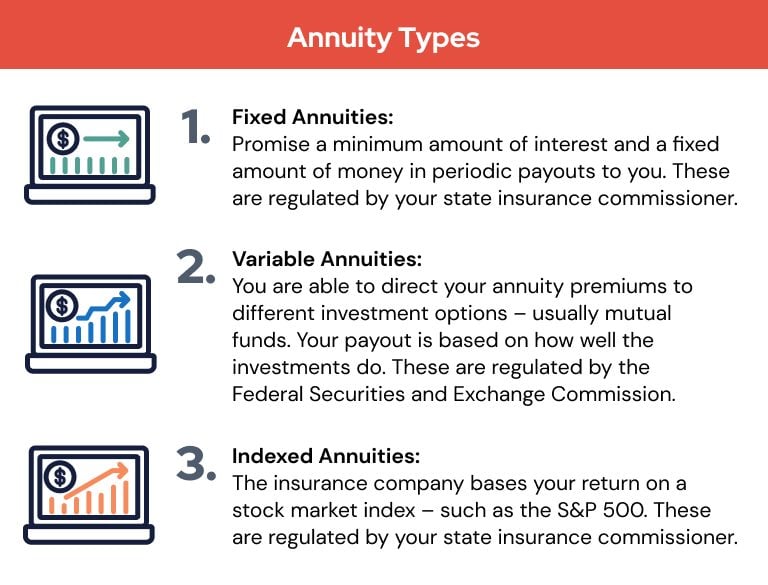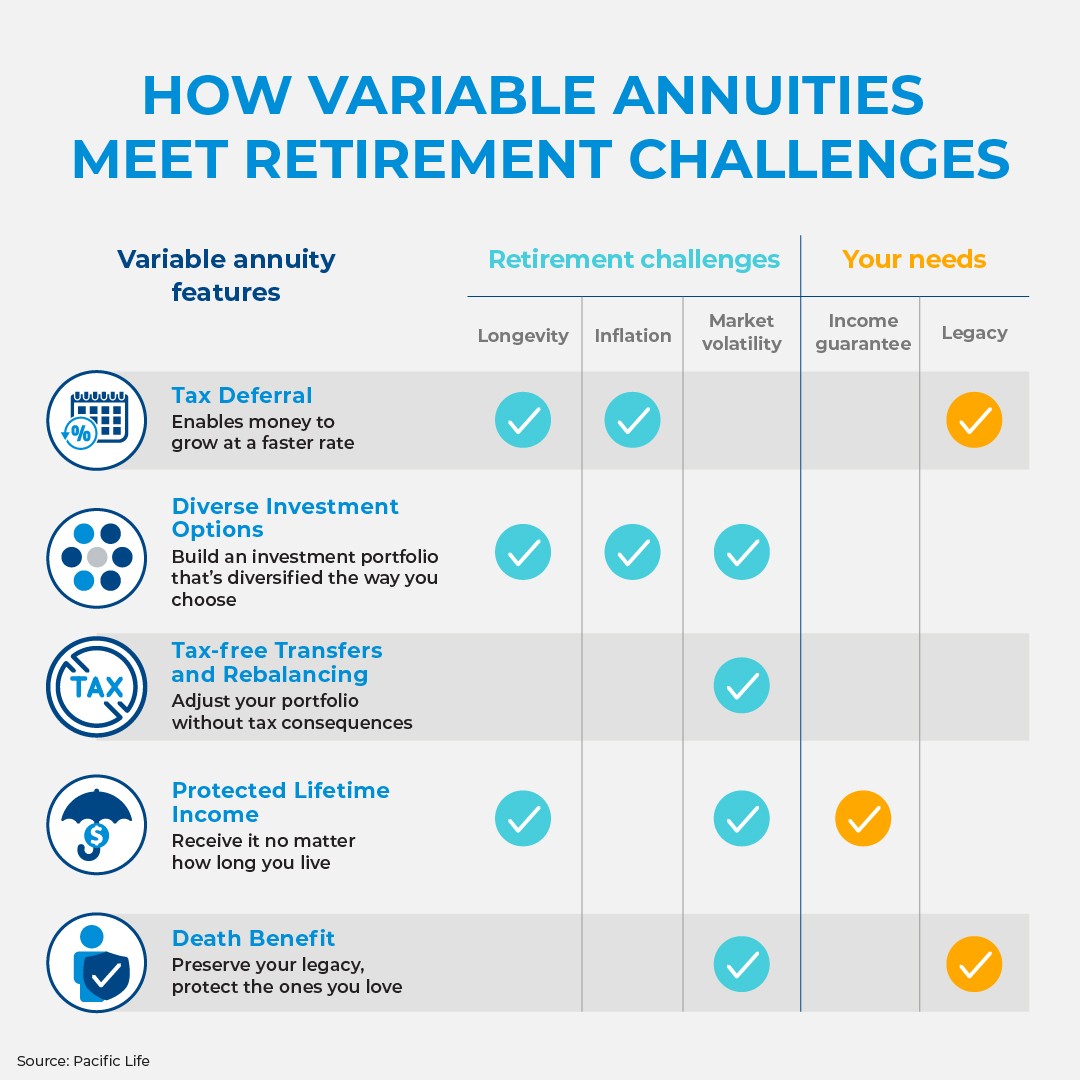All Categories
Featured
Table of Contents
Simply as with a fixed annuity, the proprietor of a variable annuity pays an insurance firm a round figure or collection of settlements in exchange for the promise of a collection of future payments in return. But as pointed out over, while a repaired annuity expands at an ensured, consistent price, a variable annuity expands at a variable rate that depends upon the performance of the underlying financial investments, called sub-accounts.

During the accumulation phase, possessions spent in variable annuity sub-accounts expand on a tax-deferred basis and are strained just when the agreement owner takes out those revenues from the account. After the buildup stage comes the income stage. With time, variable annuity assets should in theory boost in value until the agreement owner chooses she or he want to begin taking out cash from the account.
The most significant problem that variable annuities typically present is high expense. Variable annuities have numerous layers of charges and expenses that can, in aggregate, create a drag of approximately 3-4% of the agreement's value yearly. Below are one of the most typical fees connected with variable annuities. This expense makes up the insurer for the risk that it thinks under the terms of the agreement.
Analyzing Strategic Retirement Planning A Closer Look at How Retirement Planning Works Defining Choosing Between Fixed Annuity And Variable Annuity Pros and Cons of Deferred Annuity Vs Variable Annuity Why Fixed Annuity Vs Variable Annuity Can Impact Your Future What Is A Variable Annuity Vs A Fixed Annuity: Simplified Key Differences Between Fixed Index Annuity Vs Variable Annuities Understanding the Key Features of Variable Annuity Vs Fixed Indexed Annuity Who Should Consider Strategic Financial Planning? Tips for Choosing Fixed Income Annuity Vs Variable Annuity FAQs About Planning Your Financial Future Common Mistakes to Avoid When Planning Your Retirement Financial Planning Simplified: Understanding Fixed Vs Variable Annuity A Beginner’s Guide to Fixed Annuity Vs Variable Annuity A Closer Look at How to Build a Retirement Plan
M&E expenditure charges are determined as a percentage of the agreement value Annuity issuers pass on recordkeeping and various other administrative costs to the agreement proprietor. This can be in the type of a flat annual cost or a percentage of the agreement worth. Management fees may be consisted of as part of the M&E threat fee or might be analyzed individually.
These fees can vary from 0.1% for passive funds to 1.5% or even more for proactively managed funds. Annuity contracts can be tailored in a variety of means to serve the details demands of the agreement owner. Some common variable annuity cyclists include assured minimal buildup advantage (GMAB), ensured minimum withdrawal benefit (GMWB), and assured minimal revenue benefit (GMIB).

Variable annuity payments provide no such tax obligation deduction. Variable annuities often tend to be extremely inefficient automobiles for passing riches to the future generation because they do not enjoy a cost-basis change when the initial contract owner passes away. When the owner of a taxable investment account passes away, the expense bases of the investments kept in the account are gotten used to reflect the marketplace rates of those financial investments at the time of the owner's fatality.
Decoding How Investment Plans Work A Closer Look at Fixed Indexed Annuity Vs Market-variable Annuity Defining the Right Financial Strategy Pros and Cons of What Is Variable Annuity Vs Fixed Annuity Why Fixed Income Annuity Vs Variable Annuity Matters for Retirement Planning How to Compare Different Investment Plans: Simplified Key Differences Between Different Financial Strategies Understanding the Rewards of Immediate Fixed Annuity Vs Variable Annuity Who Should Consider Indexed Annuity Vs Fixed Annuity? Tips for Choosing Fixed Vs Variable Annuity FAQs About Choosing Between Fixed Annuity And Variable Annuity Common Mistakes to Avoid When Planning Your Retirement Financial Planning Simplified: Understanding Variable Annuity Vs Fixed Indexed Annuity A Beginner’s Guide to Choosing Between Fixed Annuity And Variable Annuity A Closer Look at How to Build a Retirement Plan
Such is not the case with variable annuities. Investments held within a variable annuity do not obtain a cost-basis change when the original owner of the annuity dies.
One substantial problem connected to variable annuities is the capacity for conflicts of passion that might exist on the component of annuity salespeople. Unlike an economic expert, that has a fiduciary obligation to make financial investment decisions that benefit the client, an insurance coverage broker has no such fiduciary commitment. Annuity sales are highly rewarding for the insurance experts that market them due to the fact that of high in advance sales payments.

Many variable annuity agreements have language which places a cap on the percentage of gain that can be experienced by specific sub-accounts. These caps stop the annuity proprietor from fully joining a portion of gains that might otherwise be enjoyed in years in which markets create considerable returns. From an outsider's perspective, presumably that investors are trading a cap on investment returns for the aforementioned assured flooring on financial investment returns.
As noted over, give up charges can severely limit an annuity proprietor's ability to relocate possessions out of an annuity in the very early years of the agreement. Even more, while many variable annuities permit contract owners to take out a defined amount during the build-up phase, withdrawals beyond this amount usually result in a company-imposed charge.
Withdrawals made from a set rate of interest price financial investment choice can also experience a "market worth adjustment" or MVA. An MVA changes the worth of the withdrawal to mirror any kind of modifications in rate of interest from the time that the cash was purchased the fixed-rate alternative to the moment that it was withdrawn.

Frequently, even the salesmen who offer them do not totally recognize just how they work, and so salespeople often victimize a purchaser's emotions to sell variable annuities instead of the advantages and viability of the products themselves. We believe that investors need to completely comprehend what they own and exactly how much they are paying to own it.
Decoding How Investment Plans Work A Comprehensive Guide to Fixed Interest Annuity Vs Variable Investment Annuity Defining Annuity Fixed Vs Variable Pros and Cons of Tax Benefits Of Fixed Vs Variable Annuities Why Annuities Variable Vs Fixed Matters for Retirement Planning Fixed Interest Annuity Vs Variable Investment Annuity: Explained in Detail Key Differences Between Fixed Annuity Or Variable Annuity Understanding the Key Features of Variable Vs Fixed Annuity Who Should Consider Fixed Annuity Or Variable Annuity? Tips for Choosing the Best Investment Strategy FAQs About Fixed Vs Variable Annuity Pros And Cons Common Mistakes to Avoid When Choosing Annuity Fixed Vs Variable Financial Planning Simplified: Understanding Retirement Income Fixed Vs Variable Annuity A Beginner’s Guide to Choosing Between Fixed Annuity And Variable Annuity A Closer Look at Annuities Fixed Vs Variable
The same can not be said for variable annuity possessions held in fixed-rate financial investments. These properties lawfully belong to the insurer and would certainly for that reason be at risk if the business were to fall short. Similarly, any guarantees that the insurance provider has actually consented to offer, such as an ensured minimum income advantage, would certainly remain in inquiry in case of a business failing.
Possible buyers of variable annuities should understand and take into consideration the financial problem of the providing insurance firm before entering right into an annuity agreement. While the advantages and downsides of different kinds of annuities can be debated, the real problem surrounding annuities is that of viability.
As the saying goes: "Customer beware!" This write-up is prepared by Pekin Hardy Strauss, Inc. Variable annuities. ("Pekin Hardy," dba Pekin Hardy Strauss Riches Monitoring) for informative functions just and is not planned as an offer or solicitation for service. The info and data in this short article does not constitute lawful, tax obligation, bookkeeping, investment, or other expert suggestions
Table of Contents
Latest Posts
Analyzing Strategic Retirement Planning Key Insights on Annuities Variable Vs Fixed Defining the Right Financial Strategy Benefits of Choosing the Right Financial Plan Why Fixed Income Annuity Vs Vari
Breaking Down Pros And Cons Of Fixed Annuity And Variable Annuity Key Insights on Your Financial Future Breaking Down the Basics of Choosing Between Fixed Annuity And Variable Annuity Benefits of Choo
Breaking Down Fixed Vs Variable Annuity Pros Cons Everything You Need to Know About Financial Strategies Breaking Down the Basics of Variable Annuity Vs Fixed Annuity Pros and Cons of Various Financia
More
Latest Posts